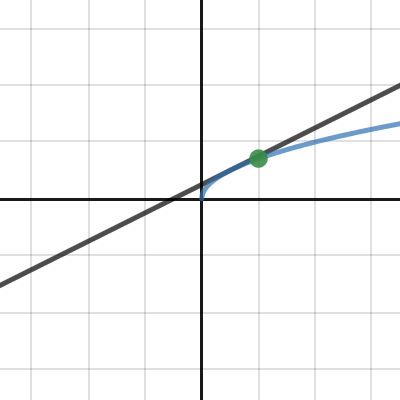MrFahrenheit
New member
- Joined
- Nov 27, 2020
- Messages
- 3
Hi there, this is my first post, I'm not an english speaker so I'm sorry if i misspel some words.
I don't know how to write summations here so I'm going to write sum(a_n) wich represents the sum from n=1 to n=infinity, and to make it easier to read I'm going to use some square brackets [] instead of normal brackets ().
I was learning about series expansions (modifying geometric series, Taylor series, etc) and then trying to find a series for sqrt(2) I found something more intresting.
Let's start with the series for e^x and ln(1+x):
e^x= sum( (x^n) / n! ) +1 (the +1 is because the series starts in 1)
ln(x+1)= sum( [ (-1)^(n+1) ] * (x^n) /n )
Then Let b and c be two real numers where 0 < b <= 1
Then we have: b^c = exp(ln(b^c)) = exp(c*ln(b))
Then write c*ln(b) as a series:
c*ln(b)=c * sum( [ (-1)^(n+1) ] [(b-1)^n] /n )
Then we write exp(c*ln(b)) using a series expansion with x=c*ln(b)
b^c = exp(c*ln(b)) = sum ( [ c * sum( [ (-1)^(n+1) ] [(b-1)^n] /n ) ]^n /n! ) +1
Bringing the c out of the exponent, breaking down (-1)^(n+1) into -(-1)^n
b^c = sum ( [ - sum( [ (-1)^n ] [(b-1)^n] /n ) ]^n * [ ( (c)^n ) /n!] ) +1
Finally, bringing the - in front of the second sum out of the exponent and merging it with the c^n to get (-c)^n and merging the (-1)^n with the (b-1)^n to get ( -(b-1) )^n = (1-b)^n
b^c = sum ( [ sum( [(1-b)^n] /n ) ]^n [ ( (-c)^n ) /n!] ) +1
About convergence, the series for e^x converges for all x and the series for ln(x+1) converges for |x|<1, so it does for |b-1|<1 which means -2 < b < 2 , but i'm going to only let b > 0 (if b=0 it seems to approach 0 but I'm not sure) and then I'm going to let b <= 1, so if you need to use b>1 you simply change the sign of c.
This series might be way too complicated (and you'd be right) but just for fun I tried using the Desmos calculator aproximation sqrt(2) (b= 1/2, c= -1/2) using 10 term for each series and i got 3 decimal places. I also tried 0^0 and it approached 1.
Here's a graph of the partial series (k determines the number of terms on both sums) for c = 1/2 vs the graph of sqrt(x). The graph is centered at x=1.

 www.desmos.com
www.desmos.com
I would like to know your opinion and help if I made a mistake. I would appreciate any idea on how to use this, information if someone discovered this before and computational help graphing with a better graphing system.
Thanks for reading!
I don't know how to write summations here so I'm going to write sum(a_n) wich represents the sum from n=1 to n=infinity, and to make it easier to read I'm going to use some square brackets [] instead of normal brackets ().
I was learning about series expansions (modifying geometric series, Taylor series, etc) and then trying to find a series for sqrt(2) I found something more intresting.
Let's start with the series for e^x and ln(1+x):
e^x= sum( (x^n) / n! ) +1 (the +1 is because the series starts in 1)
ln(x+1)= sum( [ (-1)^(n+1) ] * (x^n) /n )
Then Let b and c be two real numers where 0 < b <= 1
Then we have: b^c = exp(ln(b^c)) = exp(c*ln(b))
Then write c*ln(b) as a series:
c*ln(b)=c * sum( [ (-1)^(n+1) ] [(b-1)^n] /n )
Then we write exp(c*ln(b)) using a series expansion with x=c*ln(b)
b^c = exp(c*ln(b)) = sum ( [ c * sum( [ (-1)^(n+1) ] [(b-1)^n] /n ) ]^n /n! ) +1
Bringing the c out of the exponent, breaking down (-1)^(n+1) into -(-1)^n
b^c = sum ( [ - sum( [ (-1)^n ] [(b-1)^n] /n ) ]^n * [ ( (c)^n ) /n!] ) +1
Finally, bringing the - in front of the second sum out of the exponent and merging it with the c^n to get (-c)^n and merging the (-1)^n with the (b-1)^n to get ( -(b-1) )^n = (1-b)^n
b^c = sum ( [ sum( [(1-b)^n] /n ) ]^n [ ( (-c)^n ) /n!] ) +1
About convergence, the series for e^x converges for all x and the series for ln(x+1) converges for |x|<1, so it does for |b-1|<1 which means -2 < b < 2 , but i'm going to only let b > 0 (if b=0 it seems to approach 0 but I'm not sure) and then I'm going to let b <= 1, so if you need to use b>1 you simply change the sign of c.
This series might be way too complicated (and you'd be right) but just for fun I tried using the Desmos calculator aproximation sqrt(2) (b= 1/2, c= -1/2) using 10 term for each series and i got 3 decimal places. I also tried 0^0 and it approached 1.
Here's a graph of the partial series (k determines the number of terms on both sums) for c = 1/2 vs the graph of sqrt(x). The graph is centered at x=1.

Desmos | Graphing Calculator
I would like to know your opinion and help if I made a mistake. I would appreciate any idea on how to use this, information if someone discovered this before and computational help graphing with a better graphing system.
Thanks for reading!
